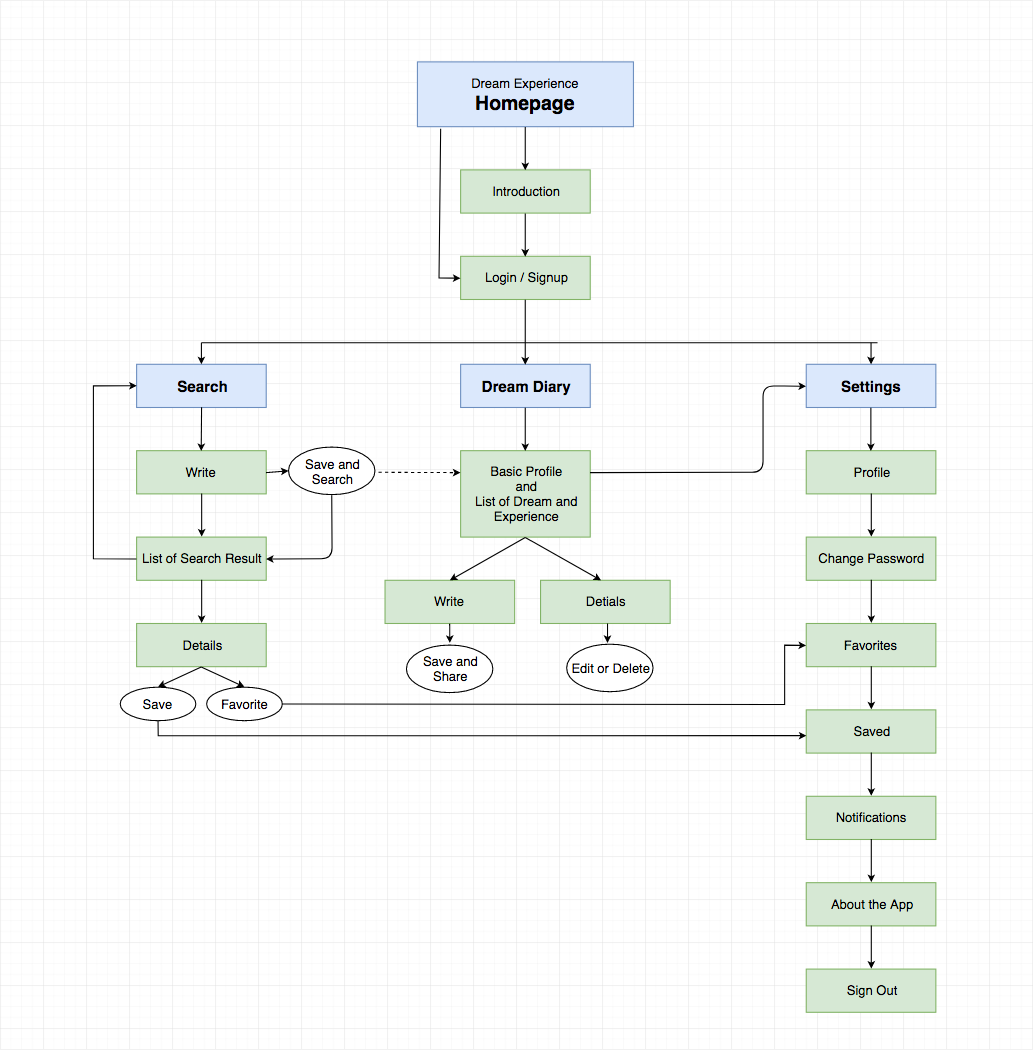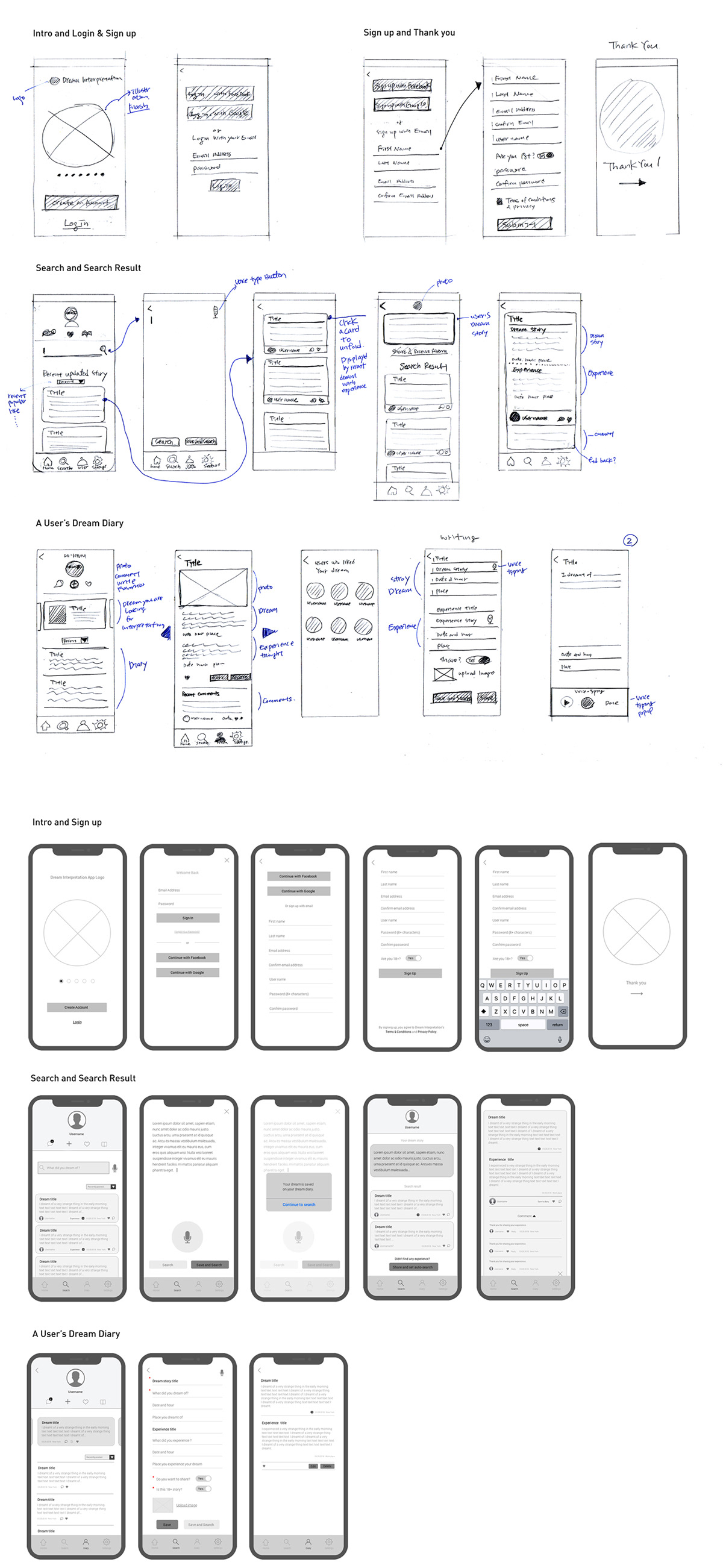
Dream are expressed irrationally, symbolically, and distortedly, so most of dream interpretation found online or in books are not correct and helpful becasue they are interpreted simply. Even if you dream the same or similar dream as others, it is interpreted differently depending on your personal realistic situation, the state of your mind, and the details of dream. Dream Interpretation is the mobile app to help people find the most accurate and realistic dream interpretation and understand why they have such a dream by sharing the stories that people who dream the same or similar dream in reality experience their dream in their daily life.
Objectives
Find an efficient and simple communication method to share experience and the idea of making users keep participating.
Interview Feedback or UX Research Plan
Number of Interview: 8 (6 women and 2 men). Age range is 25 - 44.
The respondents answered that they searched dream interpretation with a light mind for fun and out of curiosity. It seemed they didn't take it serious, but interview showed that their purpose of finding a meaning of dream is to take an action more carefully than usual in reality, psychologically to be secure or feel lucky, or to prepare in mind what's going to happen to them in the near future because they know that dream is related to reality and have experienced in a real life.
All respondents use Google or Naver to search. On both of the search engines, simple dreams can be somewhat found but complicate, symbolic, distorted, or surrealistic dreams can be hardly found from the search result because the search result shows just a list of interpretation of simple dreams. Most of respondents have not been content with the search result. some of respondents found dreams that were partially correct, and put together or applied the one they liked best.
The 33% of respondents used a dream interpretation app once but never revisited it because it is hard to figure out how to search. The categories are too divided and the numbers of a list are too large, so they don't feel like finding dream interpretation.
To find a meaning of dream, 1-3 keywords, a short sentence, or a question always with the word "dream, interpretation, meanings, and/or dictionary" are typed in a search box by the respondents. Only 3-5 results on the top of a page are clicked. They try another keywords or sentences again when they couldn't find a meaning of dream.
Making users repeat the same action gets lost their motivation, makes them time consuming, give up searching, bored, and irritated. The dream interpretation app should strengthen search function for most accurate and various search result as well as provide a convenient search and posting method such as voice-typing. It should be also considered that how only stories of users' real experiences can be searched and unsuitable answers can be removed.
It takes about 10-15 minutes for respondents to search. They feel frustration in giving up when they couldn’t find a meaning of dream after the time. They don't continue searching any more because they think they can't find it any more and are busy. To help users keep visit the app, they need automated reminders and/or alarm; they don't need to waste time to go back just to check if one answers when users answer their dream posted.
To make the process of finding a dream interpretation interesting and more expected, the suggested ideas include posting in various languages by using translator so that more people in the world can have more opportunity to see and answer one's dream. Like button, sending message, searching in the world map, emoticons, or saving dreams posted would be helpful users to get motivated to participate in.
Usability Analysis
I downloaded and tested 2 applications: Naver and Dream Wall. My competitive analysis focuses on the process of searching dream interpretation and writing a dream and my page. The evaluation takes into account different NNG usability heuristic principles. An overall evaluation of the websites according the 10 NNG usability heuristics is also present.

Persona and Empathy Map

User Stories

Cardsorting
The card sort for the dream experience app started with three users that exemplified the likely users. There were several classifications that ran through user’s vocabulary showed up: Settings, Searching, Writing, Interacting, Communication. Some of the tasks were easily grouped to Settings. The tasks for Settings were About the app, Change a username, Change alarm setting etc. Users looked a little bit confused of the tasks about search
and dream diary and first made one group with them becuase of action tasks such as “Writing”. It was interesting that the tasks about “Share”, “Favorites”, “Read”, “Save other users’ dream” were grouped to
Interacting or Communication. All users were confused of the task about “Translation”. They didn’t put it in any group and also said there was no any reason that they need or want to use it. It made me decide to remove “Translation” fuction from the app.
and dream diary and first made one group with them becuase of action tasks such as “Writing”. It was interesting that the tasks about “Share”, “Favorites”, “Read”, “Save other users’ dream” were grouped to
Interacting or Communication. All users were confused of the task about “Translation”. They didn’t put it in any group and also said there was no any reason that they need or want to use it. It made me decide to remove “Translation” fuction from the app.

Sitemap

User Flows

Sketches and Wireframes

Style Guide

